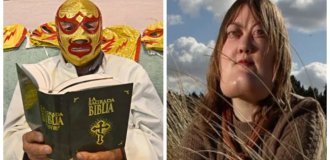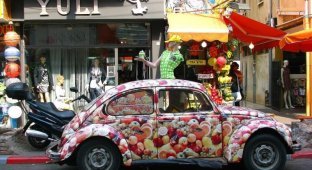Jerusalem: Protestant Golgotha, Gethsemane, Mount of Olives (40 photos)
It’s hard to write about Jerusalem. This is the city that everyone has their own. Jews pray at the Western Wall and remember the First and Second Temples, Muslims prostrate to the sounds of prayer at the Al-Aqsa Mosque, Christians atone for their sins in the Church of the Holy Sepulcher, everyone else is perplexed as to how it happened that just a few square kilometers could become the center at once for several of the world's largest religions. They say that a more or less unambiguous perception of the Old City of Jerusalem is possible only through the prism of one of the dominant religions there: because you see everything from one angle, and all other points of view are alien. If there is no unambiguous religious perception of the city, then there is a feeling of heaviness from a huge, unexpectedly falling stream of extremely heterogeneous impressions and emotions, which often simply cannot be processed.

Source: Zhurnal/marina-pavlova

1.

2. My acquaintance with the Old City began in an unconventional way: with a visit to the so-called Gordon Garden, or Garden of the Holy Sepulchre, the very place that the entire Protestant world considers to be the real Golgotha. Strictly speaking, this is not the Old City yet: the garden is located outside the fortress walls, in the Arab quarter, a short walk north of the Nablus Gate.

3. Executions in the time of Jesus, as is known, were carried out outside the cities, i.e. outside the city walls. So, Golgotha had to be somewhere near the city, but not in it. According to sources, there should be a mountain that from a distance resembles a human skull, a tomb carved into the rock, and a garden. This is exactly how the Englishman Charles Gordon reasoned in the 19th century, who was actively searching for the correct place of Golgotha and the Holy Sepulcher. Everything needed was found in the very place that is now called the Protestant Golgotha, or the Garden of Gordes. There is, in fact, only one catch: no one knows the exact location of the fortress walls in the time of Jesus. At the end of the 19th century, a Protestant community formed in England and wanted to buy this place, and now there is a beautiful and cozy garden here - a surprisingly quiet and peaceful place among the seething, noisy and dirty Arab quarter. From the observation deck at the end of the garden there is a view of the very rock that Protestants consider Golgotha:

4. The rock no longer belongs to the garden, so at the base of the rock there is a regular bus station of the Arab quarter, and on top you can see the tombstones of Muslim burials:

5. The garden itself is a quiet and peaceful place. Unlike the noisy, always crowded Church of the Holy Sepulchre, it is very cozy and surprisingly easy here. One cannot help but think that this is probably what the garden of the rich Isaiah really looked like, who, according to legend, begged for the body of Jesus and buried it in the tomb that he was preparing for himself.

6. According to legend, Jesus was crucified in the very place where there once was a garden. Archaeological excavations have shown that in these places there really was once a garden: water collectors, tanks for storing olive oil and wine were found here...

7. The entrance to the burial place itself is a small depression in the rock

8. They go inside silently, one or two at a time, without making noise, without falling on their faces and without crossing themselves. Everyone will stand, think about their own things, and then quietly leave. And nothing more.

9. Inside there is only a small carved tomb, a cross on the wall...

10. ... and the inscription: “He is not here because he has risen”:

11. Peace and tranquility. Perhaps this is precisely the feeling that is so lacking in the Church of the Holy Sepulchre, inside the “modern” Old Town.

12. Quite on the other side of the Old City, in Gethsemane, on the slope of the Mount of Olives, is the Church of the Assumption of the Virgin Mary, which is also the tomb of the Virgin Mary. According to legend, Mary was buried in the same place where her parents were buried before: Saint Anne and Saint Joachim. Saint Joseph is also buried here.

13. As with everything else in the Christian world, there is no clear version about the burial place of Mary. Orthodox and Armenians believe that Mary died in Jerusalem. Catholics, for example, believe that Mary died in Turkey, in the city of Ephesus. Be that as it may, there is a church on the site of the tomb of the Virgin Mary in Jerusalem, and it is located in the Kidron Valley.

14. The church was built in the shape of a cross: in the center is the place of the supposed burial of the Virgin Mary carved into the rock, on the left is the tomb of St. Joseph, on the right are the tombs of St. Anne and St. Joachim.

15.

16.

17. In Jerusalem, sometimes it’s hard to understand how all possible important shrines can be so close to each other. Golgotha - and right next to it, a couple of meters away, is the burial place of Christ? The Tomb of the Virgin Mary a few steps from the Garden of Gethsemane? So many significant events on such a small piece of land?.. Yes, the Garden of Gethsemane is located exactly across the road from the Church of the Assumption of the Virgin Mary.

18.

19. The Gethsemane grotto where Jesus prayed when he withdrew from the apostles

20. The same olive grove, now consisting of only a few trees. Outside, the road is now noisy, and the trees themselves, perhaps, are no longer “the same.” The question inevitably arises: “Was it really all that small and so close to each other?”

21.

22.

23.

24. On the very spot where, according to legend, Judas betrayed Christ, the Church of All Nations now stands

25.

26. And right behind the fence there is a noisy road and a bus stop

27. View from the Mount of Olives itself to the boarded-up Golden Gate, through which, according to legend, the Messiah should enter the city. The Golden Gate is located on the eastern slope of the Temple Mount, and on the western slope is the Western Wall. Knowing the Jewish tradition and fearing it, Suleiman the Magnificent ordered the gates to be boarded up. Now there is a Muslim cemetery right in front of the gate.

28.

29. And on the other side of the Kidron Valley, on the slope of the Mount of Olives, is the oldest Jewish cemetery in the world, and it is considered a great honor to be buried there. According to legend, at the end of days the Messiah will ascend the Mount of Olives and it is from there that the resurrection of the dead will begin.

thirty.

31.

32.

33. View of the city from the heights of the Mount of Olives

34.

35. Even higher, near the top of the Mount of Olives, stands the small church of Dominus Flevit, also known as the Church of the Sorrowful Lord. According to legend, at this place Jesus stopped before the entrance to Jerusalem and wept, predicting the destruction of the Temple.

36.

37. View of the city from here

38. Dome of the Rock

39. Another view of the Jewish cemetery and the city visible in the distance

40. Church of Mary Magdalene. It was not possible to get inside that day; I had to go here another day, because... This church works only 3 times a week for 2 hours























